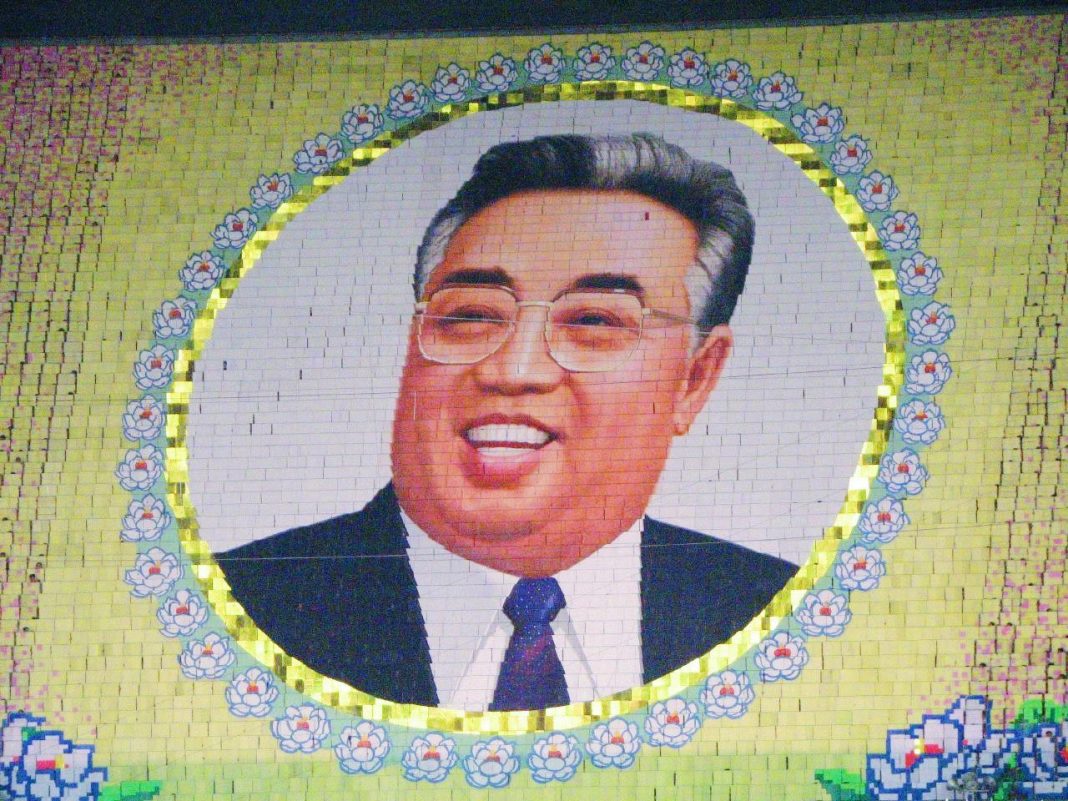Anyone interested in North Korea will have frequently come across the word “suryong.” That’s because it’s the title used by North Korea’s leaders, particularly the country’s first leader, Kim Il Sung. In Korean, the word is so strongly associated with North Korea that it is rarely used in other contexts. In this column, we’ll look at the etymology of the word and how, why, and when Kim Il Sung came to be referred to as the “suryong,” which is commonly translated in English as “supreme leader” or just “leader.”
North Korean political terminology has two sources. The first is, of course, the ordinary Korean language. The second is the Russian of the mid- to late 1940s. This is because North Korea’s regime was created by the Soviet Union.
The North Korean regime that came into existence in 1945 can be compared to a foreign substance injected into the body. While the Republic of Korea was clearly founded as the heir to the traditions and culture of the Joseon Dynasty, the Korean Empire, and colonial Korea, in the late 1940s North Korea saw the past as “feudal and backward.” North Korean leaders viewed Soviet culture as very progressive and saw the Soviet Union as a “model for the world.” As a result, the North Korean regime was modeled after the Soviet Union, and even its language was heavily influenced by the Stalin era. For example, it’s not uncommon for North Korean laws to use the phrase “In regards to…” in their titles. In the 1950s, members of the North Korean military used the very strange greeting, “Comrades, are you well?” It was a direct translation of the Russian phrase “Zdravstvuyte, tovarishchi” (Здравствуйте, товарищи).
A long history
Similarly, to accurately understand the North Korean concept of the “suryong,” we must look to its Korean and Russian roots.
The word has a long history. First appearing in the Balhae period, it has been in use to the present day and appears in texts such as the 1465 Wongak Gyeongyeonhae. Of course, before the establishment of the North Korean regime, the word was a common word with no hint of communism. It was just used to mean “leader.” If you look at newspapers before 1945, you can find articles calling David Lloyd George of Britain the “suryong” of the British Liberal Party or Adolf Hitler of Germany the “suryong” of the Nazis. However, after the division of the Korean Peninsula, the word became associated with communism.
The reason for the communist connotations of this word was, of course, the Soviet Union. Korean language books published by the Soviet Union referred to leaders Lenin and Stalin as the “suryong.” The word used in those books was a translation of the Russian word “vozhd” (вождь), meaning that if the Russian book called Stalin “vozhd,” the Korean translation would be “suryong.”
The history of the word “vozhd” predates the Soviet Union. For example, in the Russian Empire, the emperor was called the “sovereign vozhd” (державный вождь), and Grand Duke Nikolai, the commander-in-chief of the Russian army in World War I, was called the “supreme vozhd” (верховный вождь). By early 1917, the Russian Empire had collapsed and a republican regime had been established, and Prime Minister Aleksandr Kerensky or Captain Lavr Kornilov were called “vozhd.” In other words, the word was associated less with communism than with the military.

Revolutionary organizations use military language such as “struggle,” “battle,” and “war against the regime” to mobilize their members. Therefore, the Russian leftist forces at the time also used the military term “vozhd.” In other words, the term was not only used by communists. The Social Revolutionary Party, a non-communist left-wing party, called its leader Chernov “the party’s most dear vozhd” and “the working peasant’s honored vozhd.” The leader of the Social-Democratic forces, Plekhanov, was called the “wise vozhd.” In other words, the word was used by monarchists, republican democrats, and non-communist social democrats.
The reason why the word “vozhd” became the exclusive domain of the Bolshevik Party (Communist Party) is very simple. In 1918, the year after the Communist Revolution of 1917, the Bolsheviks established a one-party system and seized absolute power. After winning the Russian Civil War of 1918-23, they became the only stabilizing force in the Soviet Union. All rival factions were destroyed, and the Bolsheviks were the only ones who could be called “vozhd.” Of course, the Bolshevik regime didn’t want anyone to remember that in the past, the czars and enemies of the Bolsheviks had been called “vozhd,” and especially after Stalin seized absolute power in 1929, the Soviet media began calling him “vozhd” on an almost daily basis. So by 1945, the word “vozhd” had become synonymous with “communist leaders,” namely Lenin and Stalin.
After 1945, the Soviet Union occupied Eastern Europe and North Korea, and in the Soviet satellite regimes, the word “vozhd” was translated into local languages and used as a title for Stalin. For example, the word “führer,” which was Hitler’s title in Nazi Germany, became Stalin’s title in East Germany.

In North Korea, the word “suryong” came to be used as a translation of “vozhd.” At the time, there were only two “vozhd” in the communist world. No one else was allowed to be called a “vozhd” except for Vladimir Lenin and Joseph Stalin. Similarly, if you look at North Korean literature from the 1940s, you won’t find any references to Kim Il-sung as “suryong.” Kim Il Sung was commonly referred to as “General Kim Il Sung.” “Leader of the People,” “True Patriot,” and “Great Leader” were also used, but “suryong” was reserved for Lenin and Stalin.
One of the reasons for this was the Soviet concept of “people’s democracy” at the time. In the late 1940s, the Soviet Union disguised its political institutions as “people’s democracies” to hide the process of communization in its satellite states. Similarly, North Korea claimed that power was not vested in the “Communist Party” but in the “Democratic Front for the Unification of the Fatherland,” a coalition of progressive forces. A formal multiparty system was maintained in North Korea, and the ruling party was called the “Workers’ Party” rather than the “Communist Party” from 1946 onward. In 1949, the North and South Korean labor parties merged, but the North Korean authorities only recognized this fact on July 1, 1950. The June 30, 1950, edition of the Rodong Sinmun was the news outlet of the by-then defunct Workers’ Party of North Korea (below in gallery).
Soviet media also referred to Kim Il Sung as “Teacher Kim Il Sung” rather than “Comrade Kim Il Sung.” The first time Soviet authorities referred to Kim as “comrade” was in the text of the July 27 Armistice.
Kim Il Sung’s “suryong” title gradually gains prominence
For the same reason, North Korea did not refer to Kim Il Sung as “suryong” until 1950. After the outbreak of the Korean War on June 25, Kim Il Sung finally became the “supreme leader,” or “suryong.” On June 27, 1950, the Tusa Sinmun referred to him as “suryong,” and the Korean People’s Army newspaper used the title “Dear Suryong (Leader)” the next day, on June 28. In September 1950, the Workers’ Party of Korea’s newspaper, the Rodong Sinmun, also began to refer to Kim Il Sung as “suryong.”
On September 19, 1952, an interesting “happening” occurred in the Rodong Sinmun. In an article (below in gallery) about “the Great Suryongs,” the outlet did not use the phrase “Great Suryong (Leader) Comrade Kim Il Sung”; rather it gave Kim the “suryong” title along with Lenin and Stalin.
The first time the phrase “Great Suryong (Leader) Comrade Kim Il Sung” appeared in a Rodong Sinmun article was on October 27, 1960 (above in gallery). In fact, the article that used that title was about a foreigner: it was common during the Kim Il Sung era for foreigners to introduce new titles for the supreme leader.
By February 1969, the use of the title “Dear Suryong (Leader)” became mandatory, and after the Fifth Party Congress in 1970, Kim Il Sung’s “main title” was changed to “Great Suryong (Leader).” From then on, the phrase we all know, “The Great Suryong (Leader) Comrade Kim Il Sung,” became a common phrase in North Korea.
Fifty-three years have passed since 1970. For more than half a century, North Koreans called Kim Jong Il the “Great Suryong (Leader).” However, it’s worth remembering that the title was not used from the beginning, and its etymology is to be found outside the Korean Peninsula.
Translated by Robert Lauler.
Please send any comments or questions about this article to dailynkenglish@uni-media.net.






















